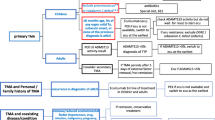Abstract
Hemolytic uremic syndrome is an important cause of acute kidney injury that requires dialysis in children. The diagnosis and management is difficult due to limited diagnostic facilities and non-availability of specific complement inhibitors. We describe salient features of the recent Indian Society of Pediatric Nephrology consensus guidelines on hemolytic uremic syndrome.
Similar content being viewed by others
References
Bagga A, Khandelwal P, Mishra K, Thergaonkar R, Vasudevan A, Sharma J, et al. Hemolytic Uremic Syndrome in a Developing Country: Consensus Guidelines. Pediatr Nephrol. 2019;34:1465–82.
Zini G, d’Onofrio G, Briggs C, Erber W, Jou JM, Lee SH, et al. ICSH recommendations for identification, diagnostic value, and quantitation of schistocytes. Int J Lab Hematol. 2012;34:107–16.
Loirat C, Fakhouri F, Ariceta G, Besbas N, Bitzan M, Bjerre A, et al. An international consensus approach to the management of atypical hemolytic uremic syndrome in children. Pediatr Nephrol. 2016;31:15–39.
Huemer M, Diodato D, Schwahn B, Schiff M, Bandeira A, Benoist JF, et al. Guidelines for Diagnosis and Management of the Cobalamin-related Remethylation Disorders cblC, cblD, cblE, cblF, cblG, cblJ and MTHFR Deficiency. J Inherit Metab Dis. 2017;40:21–48.
Sinha A, Gulati A, Saini S, Blanc C, Gupta A, Gurjar BS, et al. Prompt plasma exchanges and immunosuppressive treatment improves the outcomes of anti-factor H autoantibody-associated hemolytic uremic syndrome in children. Kidney Int. 2014;85:1151–60.
Watson R, Lindner S, Bordereau P, Hunze EM, Tak F, Ngo S, et al. Standardisation of the factor H autoantibody assay. Immunobiology. 2014;219:9–16.
Khandelwal P, Thomas CC, Rathi BS, Hari P, Tiwari AN, Sinha A, et al. Membrane-filtration based plasma exchanges for atypical hemolytic uremic syndrome: Audit of efficacy and safety. J Clin Apher. 2019;34:555–62.
Puraswani M, Khandelwal P, Saini H, Saini S, Gurjar BS, Sinha A, et al. Clinical and immunological profile of antifactor H antibody associated atypical hemolytic uremic syndrome: A nationwide database. Front Immunol. 2019;10:1282.
Khandelwal P, Gupta A, Sinha A, Saini S, Hari P, Dragon Durey MA, et al. Effect of plasma exchange and immunosuppressive medications on antibody titers and outcome in anti-complement factor H antibody-associated hemolytic uremic syndrome. Pediatr Nephrol. 2015;30:451–7.
Author information
Authors and Affiliations
Corresponding author
Rights and permissions
About this article
Cite this article
Khandelwal, P., Bagga, A. Guidelines on Hemolytic Uremic Syndrome by Indian Society of Pediatric Nephrology: Key Messages. Indian Pediatr 57, 744–747 (2020). https://doi.org/10.1007/s13312-020-1920-9
Published:
Issue Date:
DOI: https://doi.org/10.1007/s13312-020-1920-9




